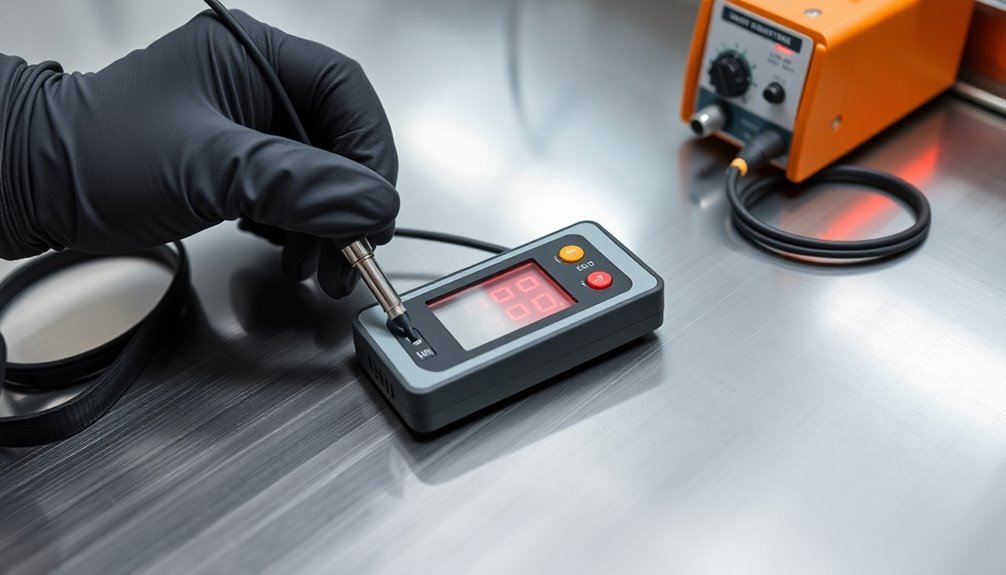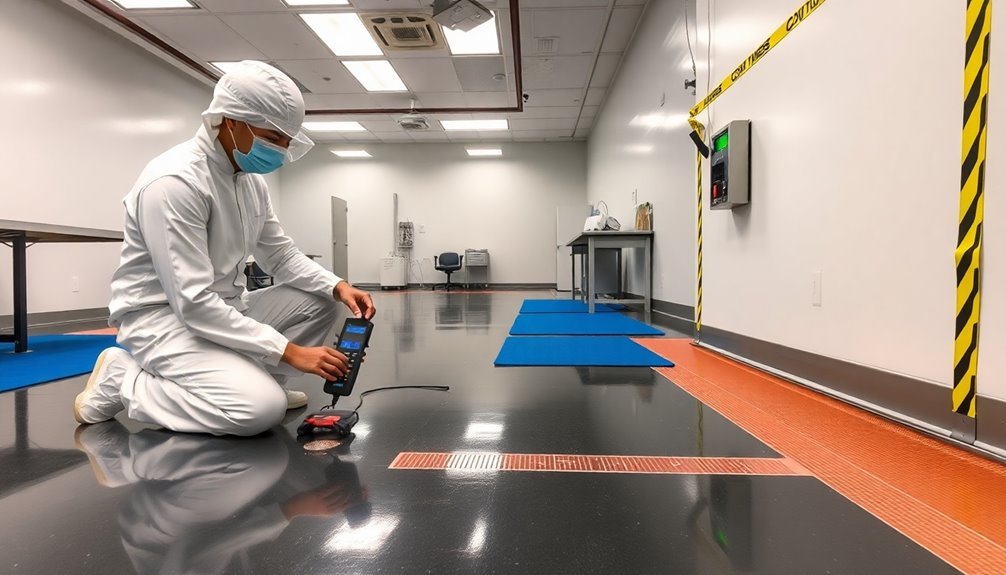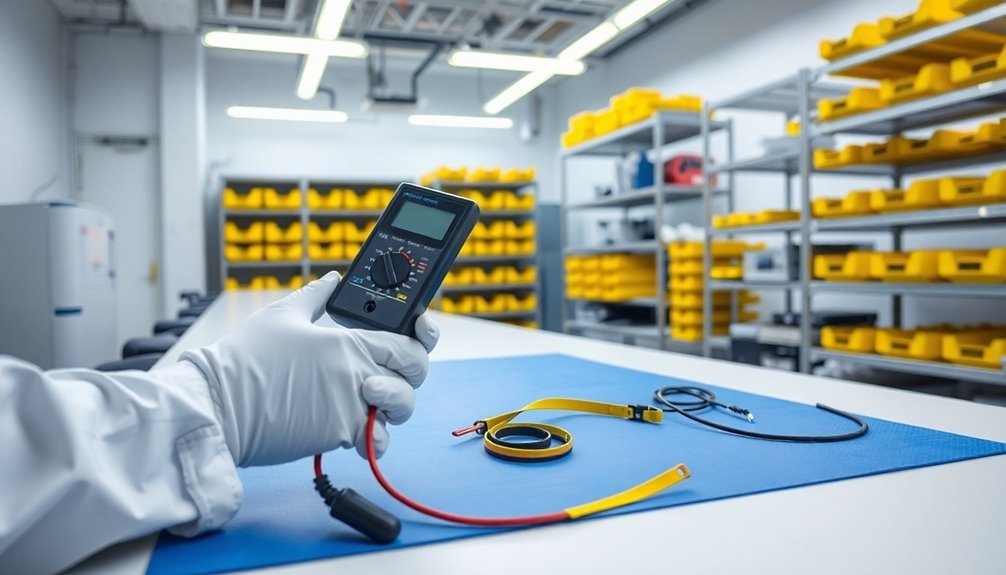You'll find three highly effective methods for inspecting static control areas. First, conduct electrical resistance testing using a resistance meter to measure point-to-point and ground resistance values, ensuring they meet ANSI/ESD standards. Second, perform body voltage measurements with tools like charge plate monitors or wireless devices to track static buildup during movement. Third, implement thorough static control evaluations using surface resistance testers and ESD event detection tools to identify potential vulnerabilities. These proven inspection techniques work together to maintain reliable ESD protection, and there's much more to discover about each method's specific applications.
Electrical Resistance Testing Procedures

Three key standards guide electrical resistance testing in static control areas: ANSI/ESD STM 7.1, ASTM F150, and OSHA 1910.333. These standards outline essential procedures you'll need to follow when testing your static control flooring's electrical resistance and ensuring workplace safety.
To conduct proper resistance testing, you'll need specialized equipment including a resistance meter, megohmmeter, or multimeter. Place two 5-pound electrodes exactly 3 feet apart on the floor surface. Begin by applying 10 volts for your initial reading. If you measure resistance at or above 1.0 x 10^6 ohms, increase the voltage to 100 volts and maintain it for at least 15 seconds until the reading stabilizes.
Your readings must fall within industry-specific ranges. For electronics manufacturing, you'll need resistance below 1.0 x 10^9 ohms, while communications facilities require readings between 1.0 x 10^6 and 1.0 x 10^9 ohms. Keep in mind that environmental factors like temperature and humidity can affect your test results.
Remember to measure both point-to-point resistance and resistance to ground. One electrode should remain stationary while you test different floor areas. Always follow safety practices to prevent electrical shock during testing procedures.
Body Voltage Measurement Methods
While electrical resistance testing provides foundational data about your static control surfaces, measuring body voltage offers direct insight into how people interact with these surfaces.
Human self-capacitance is typically around 100 picofarads (pF) when measuring voltage levels.
You'll need to use either traditional wired methods or modern wireless techniques to effectively monitor static charge buildup on personnel.
Walking body voltage tests serve as your primary measurement tool, requiring individuals to walk on floors while wearing specified footwear connected to charge plate monitors.
You must keep measurements under 100 volts for electronics manufacturing or 500 volts for end-user environments to meet ANSI/ESD S20.20 standards.
Remember to test with the exact shoes your staff will wear, as footwear considerably impacts results.
You can now utilize wireless measurement devices, such as the StatIQ Arm Band, which offer greater mobility and continuous monitoring capabilities.
These devices use electric field mills to measure local surface charge density and can detect sudden voltage drops indicating static discharge events.
You'll find that wireless sensors provide comparable results to traditional electrostatic voltmeters but offer the advantage of real-time monitoring across your entire facility, making them invaluable for identifying ESD hazards and validating your static control program.
Complete Static Control Evaluation

In accordance with industry standards, a complete static control evaluation encompasses multiple testing methods to guarantee extensive ESD protection.
You'll need to conduct resistance testing using megohmmeters and implement static field meters to measure surface voltage and polarity on objects within your EPA.
To guarantee extensive protection, you should perform static control audits that combine resistance testing with walking body voltage tests.
You'll want to use ESD event detection tools, like the EM Eye ESD Event Meter, to identify potential problem areas and measure discharge events.
Surface resistance testers are essential for compliance with ANSI/ESD S20.20 and ANSI/ESD S4.1 standards.
Static code analysis tools can enhance your testing process by identifying potential vulnerabilities without executing the code.
Your evaluation should include detailed inspections of ESD floors, verification of automated processes, and thorough material testing in the EPA.
Don't forget to assess ESD device sensitivity and evaluate the effectiveness of your ESD control products.
This extensive approach offers several benefits: you'll identify potential issues early, enhance reliability of ESD-sensitive items, and maintain cost-effective operations.
Frequently Asked Questions
How Often Should ESD Flooring Be Recertified or Retested?
You'll need to retest your ESD flooring at least six times yearly, after maintenance, or based on your facility's specific needs. Daily checks may be required for critical areas requiring constant monitoring.
What Environmental Factors Can Affect ESD Test Results?
You'll find that humidity levels, temperature variations, physical movement, and equipment handling greatly affect your ESD test results. Both high humidity and controlled temperatures help reduce static charges during testing procedures.
Can ESD Flooring Lose Effectiveness Over Time With Heavy Foot Traffic?
Yes, your ESD flooring can lose effectiveness due to heavy foot traffic. You'll notice wear patterns, material degradation, and reduced static dissipation ability over time. That's why regular testing is essential.
Which Test Method Is Most Cost-Effective for Small Facilities?
You'll find resistance testing is your most cost-effective option. It's quick, requires minimal equipment, and you can perform it in-house. Plus, it'll give you essential data about your ESD floor's basic performance.
Are Portable ESD Testing Devices as Reliable as Professional Testing Equipment?
You can't rely on portable ESD testing devices as much as professional equipment. They're less accurate, have limited capabilities, and don't fully comply with industry standards, though they're useful for basic spot checks.
In Summary
You'll get the most reliable static control assessment by combining electrical resistance testing, body voltage measurements, and thorough evaluations of your workspace. Don't rely on just one method – integrate all three approaches for extensive monitoring. Test regularly, document your results, and address any issues immediately to maintain proper ESD protection for your sensitive electronic components and equipment.





Leave a Reply